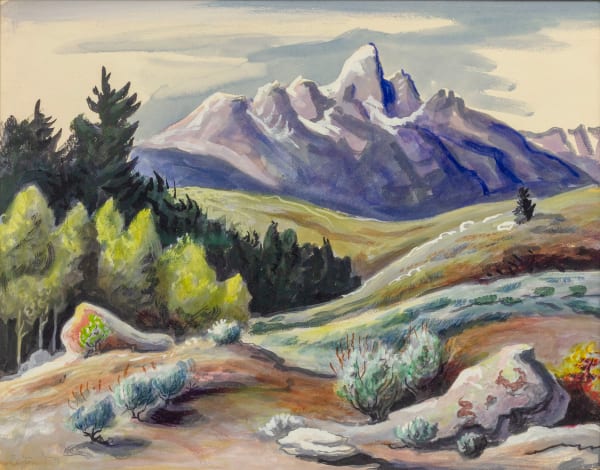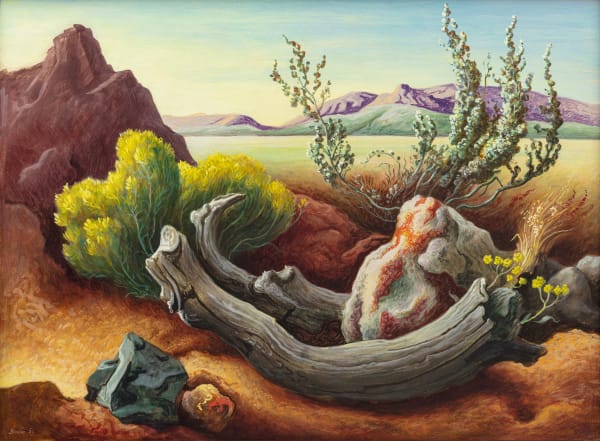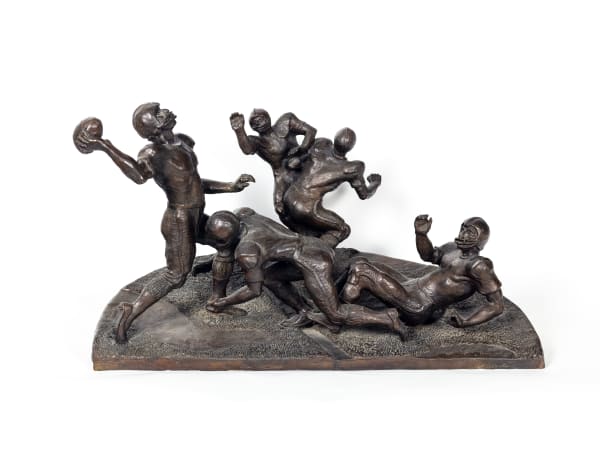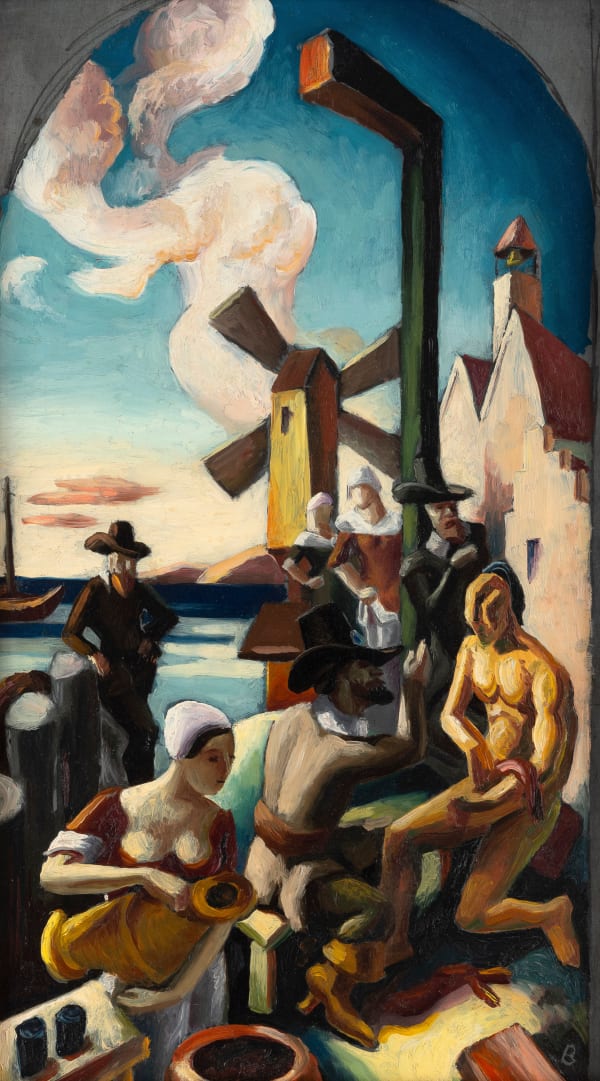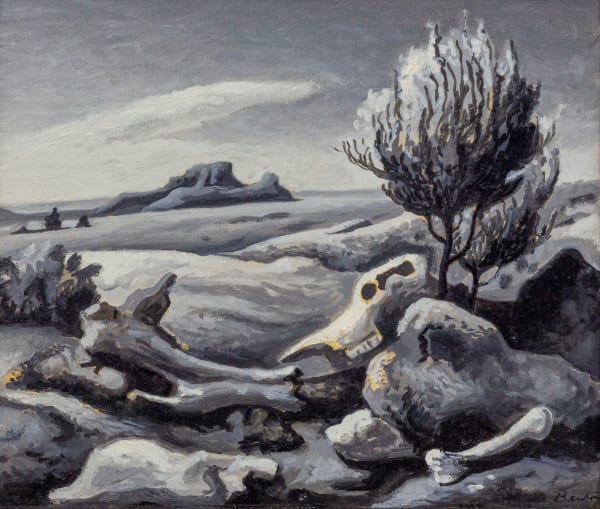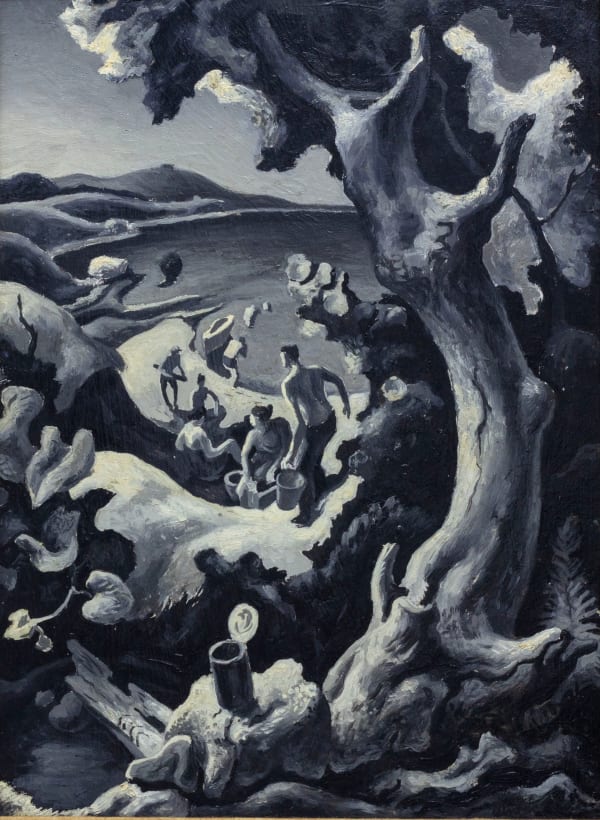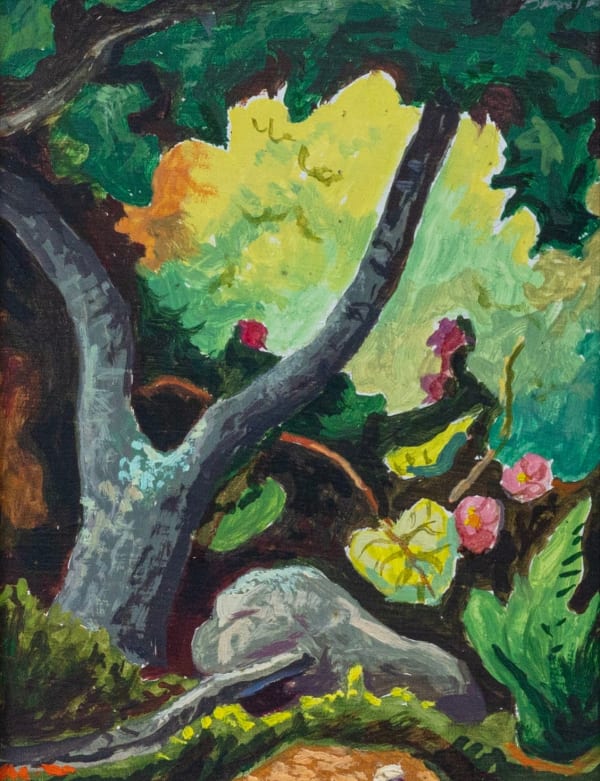Thomas Hart Benton 1889-1975
Born in Missouri into a politically influential family in 1889, Benton found inspiration among working class communities in rural America. A prolific painter, sculptor, printmaker and gifted storyteller, Benton is credited with leading the Regionalist movement in the United States early in his career. He has long been celebrated as the most innovative practitioner of mural painting depicting American life. This mastery is on display in America Today (1930–31; Metropolitan Museum of Art) and Arts of Life in America (1932; New Britain Museum of American Art).
Benton studied at prestigious institutions including the Art Institute of Chicago in 1907 and the Académie Julian in Paris, where he met fellow American painter, Synchromist Stanton Macdonald-Wright. Settling in New York in 1911, Benton’s work remained largely abstract until the early 1920s. On a 1924 trip home to visit his father, he was inspired to revisit his midwestern roots and began painting American rural subjects such as life in coal mines, steel mills and cotton fields. The influence of Spanish Old Master El Greco is evident in Benton’s naturalistic style, sculpted figures and fluid lines. While the rhythmic distortions of Benton’s compositions were informed by his European study, his work reflects a vibrant diversity that is distinctly American.
Benton was the first artist to be featured on the cover of Time magazine and his murals hung at an early site of the Whitney Museum of American Art. It was during this time that Benton formed a close alliance with his student - and frequent guest at his Martha’s Vineyard studio - Jackson Pollock.
-
 Thomas Hart BentonStill Life
Thomas Hart BentonStill Life -
 Thomas Hart BentonChilmark Landscape, 1925
Thomas Hart BentonChilmark Landscape, 1925 -
 Thomas Hart BentonStudy for "American Historical Epic — Colonial Expansion: The Jesuits", 1926
Thomas Hart BentonStudy for "American Historical Epic — Colonial Expansion: The Jesuits", 1926 -
 Thomas Hart BentonStudy for "American Historical Epic — Colonial Expansion: The Pathfinder", 1926
Thomas Hart BentonStudy for "American Historical Epic — Colonial Expansion: The Pathfinder", 1926 -
 Thomas Hart BentonEdge of the Field (Cotton Pickers), 1943-61
Thomas Hart BentonEdge of the Field (Cotton Pickers), 1943-61 -
 Thomas Hart BentonSunbathers, Boat and Beach, 1947
Thomas Hart BentonSunbathers, Boat and Beach, 1947 -
 Thomas Hart BentonStudy for "Menemsha Harbor", 1951
Thomas Hart BentonStudy for "Menemsha Harbor", 1951 -
 Thomas Hart BentonThe Plains, 1953
Thomas Hart BentonThe Plains, 1953 -
 Thomas Hart BentonStudy for "Utah Highlands", 1953
Thomas Hart BentonStudy for "Utah Highlands", 1953 -
 Thomas Hart BentonStudy for "The Kentuckian", 1954
Thomas Hart BentonStudy for "The Kentuckian", 1954 -
 Thomas Hart BentonStudy for "The Kentuckian", 1954
Thomas Hart BentonStudy for "The Kentuckian", 1954 -
 Thomas Hart BentonThe Sheepherder, 1955
Thomas Hart BentonThe Sheepherder, 1955 -
 Thomas Hart BentonThe Desert, 1956
Thomas Hart BentonThe Desert, 1956 -
 Thomas Hart BentonWyoming Landscape, 1967
Thomas Hart BentonWyoming Landscape, 1967 -
 Thomas Hart BentonPaint Mill Brook, Chilmark (Woodland Stream), 1969
Thomas Hart BentonPaint Mill Brook, Chilmark (Woodland Stream), 1969 -
 Thomas Hart BentonThe Brook, 1969
Thomas Hart BentonThe Brook, 1969 -
 Thomas Hart BentonForward Pass, 1970
Thomas Hart BentonForward Pass, 1970 -
 Thomas Hart BentonStill Life, 1972
Thomas Hart BentonStill Life, 1972 -
 Thomas Hart BentonJon Boat, Buffalo River – Study (Making Camp), 1973
Thomas Hart BentonJon Boat, Buffalo River – Study (Making Camp), 1973 -
 Thomas Hart BentonWyoming Autumn, 1974
Thomas Hart BentonWyoming Autumn, 1974 -
 Thomas Hart BentonStudy for "American Historical Epic — Colonial Expansion: Struggle for the Wilderness", c. 1924-26
Thomas Hart BentonStudy for "American Historical Epic — Colonial Expansion: Struggle for the Wilderness", c. 1924-26 -
 Thomas Hart BentonStudy for "History of New York: 1653 — Colonial Era (Pilgrims and Indians)", c. 1927
Thomas Hart BentonStudy for "History of New York: 1653 — Colonial Era (Pilgrims and Indians)", c. 1927 -
 Thomas Hart BentonDesert Still Life, c. 1951
Thomas Hart BentonDesert Still Life, c. 1951 -
 Thomas Hart BentonStudy for "Desert Still Life", c. 1951
Thomas Hart BentonStudy for "Desert Still Life", c. 1951 -
 Thomas Hart BentonDesert Still Life, c. 1951
Thomas Hart BentonDesert Still Life, c. 1951 -
 Thomas Hart BentonStudy for "Picnic", c. 1952
Thomas Hart BentonStudy for "Picnic", c. 1952 -
 Thomas Hart BentonThe Sheepherder, c. 1955-57
Thomas Hart BentonThe Sheepherder, c. 1955-57 -
 Thomas Hart BentonWyoming Landscape, c. 1955-60
Thomas Hart BentonWyoming Landscape, c. 1955-60 -
 Thomas Hart BentonStudy for "Trading at Westport Landing (Old Kansas City)", c. 1956
Thomas Hart BentonStudy for "Trading at Westport Landing (Old Kansas City)", c. 1956 -
 Thomas Hart BentonDesert Dawn, c. 1961
Thomas Hart BentonDesert Dawn, c. 1961 -
 Thomas Hart BentonLandscape, c. 1961
Thomas Hart BentonLandscape, c. 1961 -
 Thomas Hart BentonTrail Riders, c. 1964-65
Thomas Hart BentonTrail Riders, c. 1964-65
-

Art Basel Miami Beach
December 5 - 7, 2025Read more -

Thomas Hart Benton
Where Does The West Begin? October 18 - December 6, 2024Schoelkopf Gallery is pleased to present Thomas Hart Benton: Where Does the West Begin? , an exhibition of 48 paintings and works on paper drawn principally from the rich holdings...Read more
-
Art Basel Miami Beach
December 5 - 7, 2025Schoelkopf Gallery is pleased to return to the 2025 edition of Art Basel Miami Beach, taking place from December 5-7, 2025. As the United States...Read more -

Art Basel | Miami Beach
December 6 - 8, 2024Schoelkopf Gallery presents a dynamic selection of paintings, works on paper, and assemblage by leading American modern, post-war, and contemporary artists including Mary Abbott, Milton...Read more
-
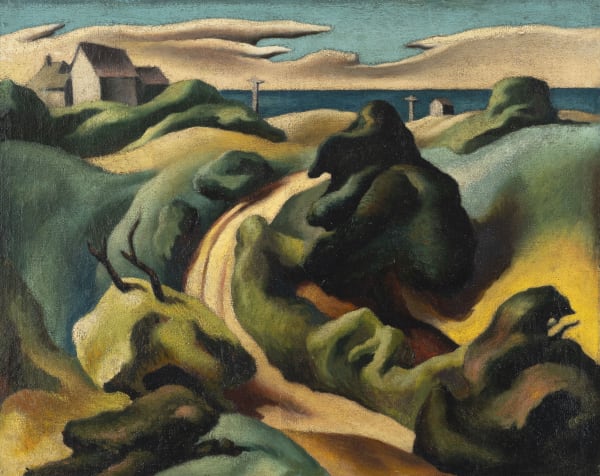
Thomas Hart Benton and Martha's Vineyard
April 26, 2024Read more -
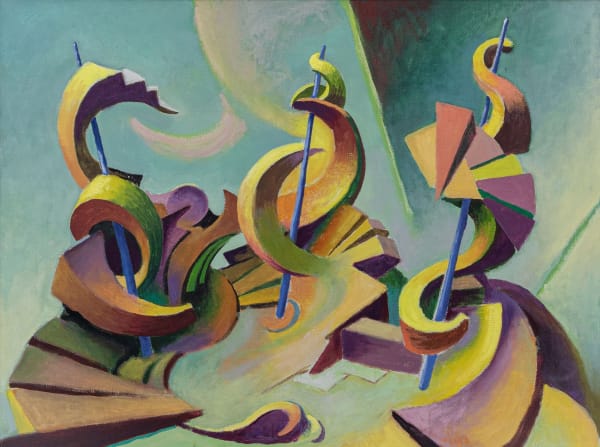
Thomas Hart Benton: Ultramodern
By Erika Doss March 2025Thomas Hart Benton (1889–1975) is generally considered a representational artist, a painter of colorful and dynamic pictures highlighting American landscapes, laborers, and everyday life. During...Read more
-

Puck | An Art Collection’s Escape From L.A.
American Stories: The Kathleen Kennedy and Frank Marshall Collection January 2025By Julie Davich, January 19, 2025 Kathleen Kennedy and Frank Marshall decided to sell their collection six months before fires ravaged Los Angeles. Now, dozens...Read more -

Now Representing | Thomas Hart Benton
November 2023NEW YORK (November 2023) : Schoelkopf Gallery – the leading gallery in the field of American art – is honored to announce exclusive worldwide representation...Read more













